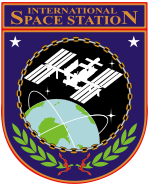The station can be seen from the Earth with the naked eye, and, as of 2009[update], is the largest artificial satellite in Earth orbit, with a mass larger than that of any previous space station. The ISS and its experiments are operated by long-duration Expedition crews, with the station being continuously staffed since the first resident crew, Expedition 1, arrived on 2 November 2000. This has provided an uninterrupted human presence in space for the last 9 years and 43 days. As of 1 December 2009[update], the crew of Expedition 22 is aboard.
 | |||||
| The International Space Station on 25 November 2009 as seen from the departing Space Shuttle Atlantis during STS-129. | |||||
 | |||||
| ISS Insignia | |||||
| Station statistics | |||||
|---|---|---|---|---|---|
| NSSDC ID: | 1998-067A | ||||
| Call sign: | Alpha | ||||
| Crew: | 6 | ||||
| Launch: | 1998–2011 | ||||
| Launch pad: | KSC LC-39, Baikonur LC-1/5 & LC-81/23 | ||||
| Mass: | 344,378 kg (759,222 lb) | ||||
| Length: | 73 m (240 ft) from PMA-2 to Zvezda | ||||
| Width: | 108.5 m (356 ft) along truss, arrays extended | ||||
| Height: | c.20 m (c.66 ft) nadir–zenith, arrays forward–aft | ||||
| Living volume: | c.373 m³ (c.13,172 ft³) | ||||
| Atmospheric pressure: | 101.3 kPa (29.91 inHg) | ||||
| Perigee: | 336 km altitude (181 nmi) | ||||
| Apogee: | 346 km altitude (189 nmi) | ||||
| Orbit inclination: | 51.6419 degrees | ||||
| Average speed: | 27,743.8 km/h (17,239.2 mph, 7,706.6 m/s) | ||||
| Orbital period: | c.91 minutes | ||||
| Days in orbit: | 4043 (15 December 2009) | ||||
| Days occupied: | 3332 (15 December 2009) | ||||
| Number of orbits: | c.63807 (15 December 2009) | ||||
| Orbital decay: | 2 km/month | ||||
| Statistics as of 27 November 2009 (unless noted otherwise) | |||||
| References: | |||||
| Configuration | |||||
 | |||||
| Station elements as of 25 November 2009[update]. | |||||
The station represents a union of several space station projects including the American Space Station Freedom, the Soviet/Russian Mir-2, the European Columbus and the Japanese Kibō.
The ISS is operated as a joint project between the American National Aeronautics and Space Administration (NASA), the Russian Federal Space Agency (RKA), the Japan Aerospace Exploration Agency (JAXA), the Canadian Space Agency (CSA), and the European Space Agency (ESA)

0 comments: on "International Space Station"
Post a Comment